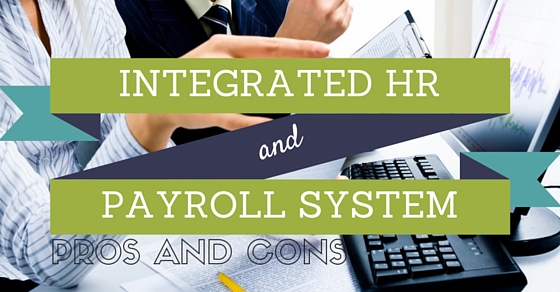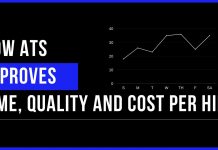The Cambridge dictionary defines integrated HR as the process of combining all the systems that helps in managing and using human resources in a business so they work effectively together for the best results.
Pay roll is defined as the list of the company employees stating what their company designations are, along with the amount to be paid to them, in the form of salaries and other incentives.
In the modern work culture, human outsourcing and payroll management go hand in hand. This is where integration of human resources and the payroll system takes place.

Why Payroll System?
If the business have one or more associate employees, it is necessary to define a payroll system within the company. Many companies use human resources or leasing companies or try to use automated payroll services and software to manage these with utmost precision and privacy.
There are many factors that define the payroll systems. These include:
1. Time and wages:
A payroll system keeps in track of the amount you have to pay to the employees through the number of hours that they have worked, the amount of wages that they are supposed to get per hour and keeping in track of the amount of holidays and leaves that they have taken during the paid time. This also improves the employees’ motivation and also encourages the employee to do more.
2. Taxes and withholding:
While maintaining a company within a booming industry, there are certain rules and regulations that should be followed by the head of the company. These rules and regulations are set by the state and the federal department of the respective countries.
One of the most basic rules is the timely payment of taxes and other fees by the company to the government of that country.
A payroll system calculates how much the company owes to the government in the form of taxes and how to comply with such regulations. This system can automatically deduce the amount that you are obliged to pay the taxing authorities. It also does wage deductions and wage cut offs.
3. Reporting:
The main purpose of managing payroll systems is the management of one of the most expensive resources of a company – its labour. Labour is the most expensive and highly maintained part of the organization.
A payroll system generates a list of monthly, hourly and weekly employees. It also categorizes the employees on the basis of the type of work they do.
For example whether if they are leased or original employees of the company. Also, they provide ease to the mangers in checking the number of employees absent and present within a present day, the amount of salary earned by an employee and the highest and the lowest earner within the employee pool.
Pros and Cons of an Integrated HR and Payroll System:
| S.no | Pros | Cons |
| 1 | Reduction of Paper Work | Lack of synergy |
| 2 | Updation | High cost |
| 3 | Specialized reports | Difference in priorities |
| 4 | Time | Misunderstanding |
| 5 | Consolidation | Data security |
| 6 | Accuracy | Cyber security and fraud |
| 7 | Gauging employee performance | Information access |
| 8 | Freeing administrative time and focus | Lack of quality |
| 9 | Detection of profit leakages | Less control |
Pros of an Integrated HR and Payroll System:
1. Reduction of paperwork:
Most of the documents needed are common for both the human resource department and the payroll system. The best advantage of integrating the human resources with the payroll system is that the amount of papers required for filing the information is very much reduced.
This is because most of the payroll systems used are highly automated in nature and do not require much printing and physical storage. They are usually stored as digital data and is stored in the payroll system database within the company.
2. Updation:
In addition to reduction of paperwork, automated payroll systems also does a great job in automatic updation about the employees. Since most of the documents involved for both the human resource department and the payroll department are the same, they require the same database for future referencing.
The database includes employee information, the wages and other personal details of the employee. When the database administrator enters a relevant information into the database, the payroll system automatically updates and computes the payroll relevant to the information obtained.
For example, if a company has terminated an employee, and they have to update the details, all they have to do is, remove and delete the employee details in the database and the payroll system automatically does the same in regards of the payroll information about the employee. This can be a great time saver and also helps in reducing errors up to a great margin.
3. Specialized reports:
Most of the companies require details about the employees and other related information for consolidated packages. This report contains not only the employees’ name and payroll scale but also other personal information.
This cannot be materialized and fabricated without the help of the human resource department and accessing the payroll system and the employee databases. Hence, highly confidential information can also be accessed by the companies through such databases.
4. Time:
One of the basic advantages of integrating both these factors, is that all the details can be easily entered by a single person. This defeats all the errors formed when the same information had to be entered by two different individuals at different departments. This results in more simplified data entry tasks.
5. Consolidation:
An added benefit of integrating database is consolidating both the information from the human resource department and the payroll system. This makes it easier for the employees to access about their information and also provide security so that no other third person can tamper with the given information.
If you could authorize the employees themselves to update and view their details, it could reduce the data entry and administration efforts by up to 80%.
6. Accuracy:
Having more employees and other personnel interfere and access with the database information can bring errors in the information knowingly and unknowingly.
For example, the human resource employees accidentally entered the wrong database information, this can cause problems not only for both the divisions but also across all department where these information is relevant and important.
By unifying the data entry process and also assigning a few employees for data entry, a large number of errors can be reduced. This can be applicable for data entry purposes for multiple departments.
7. Gauging employee performance:
An integrated system enables you to create a more satisfied and more designed work for various factors such as creating an efficient employee training and orientation programme.
This can also act as an added feature of comparing the performance of a working individual, with respect to others in an organization. Analyzing such data can lead to new employment approaches and recruitment practices.
8. Freeing administrative time and focus:
The human resource staff and employees will be the first to note how much time and energy your employees are spending on a new task or project. This type of low level activity employs a new employee process basically streamlining a new training approach for the employees or introducing a new HR system.
With the payroll and human resource integration the human resource can enter any type of data, from staff reviews and suggestions to the necessary information regarding payrolls and tax information and mandatory payroll forms.
These are all integrated into the system as a single entity. This prevents expanding valuable resources and capital in collecting various information from different areas at different times and tedious inputting of employee data.
9. Detection of profit leakages:
Payroll can easily be out of control, if not managed carefully. It leads to severe losses for the company and for the associated clients. The human resource departments can check into the payroll database and detect for any susceptible profit leakages. Such payroll leakages can be disastrous and can incur losses to the companies irrespective of the size of the company.
The best method to solve such a problem is the integration of the finance department and the human resource department of the company. Both the sides should work hand in hand so as to prevent such losses knowingly and unknowingly. The three main reasons that can incur liabilities are:
1. Reducing the associated paperwork.
2. Reducing the company exposure for safety purposes.
3. Improving the efficiency and the morale of the company.
To reduce the dependency of payroll systems, the best method is to use interfaced human resources and payroll systems. That is, using multiple outsourcing companies for a single client company.
This can provide motivation and encourage a healthy competition between the two leasing companies and the client company will get the ultimate authority and power and it can be used to exercise authority over both the groups.
Cons of an Integrated HR and Payroll System:
Certain decisions are to be taken when deciding whether integration of the human resource department and the payroll system is the best option for you.
1. Lack of synergy:
While maintaining a small business, it is important to maintain a certain level of synergy within the different organizations and along with other companies. This level of synergy is expected for both the human resource department and the payroll systems.
Each department has their own set of rules and protocols that the employees are comfortable with. Combining different levels of rules and protocols while integrating different areas can be confusing for the employees and can decrease the productivity of that certain branch.
2. High cost:
Integrating different branches may save you a lot of money in the long term, but it can be highly expensive when in used for short terms. Also, such integrations requires a lot of resources and if your company does not have the sufficient financial stability, this can provide loss for the company.
Moreover, problems arising from the leased and the native employees such as lack of communication, unmatched skills in both the department and insufficient training for both the departments can lead to a huge loss in capital and resources. This can also lead to a failure in delivering the results as expected by the company.
3. Difference in priorities:
Each department has their own set of priorities. It can be disastrous when different department do not follow those priorities and hence provide inefficient services.
This can also create unsatisfactory customers, such as delay in providing customer feedbacks and delay in issuing paycheck for the employees and so on. This can create further misunderstanding between the two departments.
4. Misunderstanding:
The more workers you have in a company, the more there are chances of communication and more will be the cases of misunderstandings and poor communication. Certain companies may treat integration as a chance of future layoffs, hence decreasing the employee morale and productivity.
Once integrated with a different department, many problems will arise due to poor communication, difference in priorities, disagreement or personal opinions. These differences both in the professional and at personal level will provide many difficulties to the company in the future, such as slowing down the company’s productivity and agility. This can also create a bad name for the company.
Finding The Right Payroll Service:
Every company is different from one another each have their own set of values and motives. No company is 100% identical to one another. Similarly, there is no single payroll software that is truly satisfactory for one particular type of Client Company. The real success lies in how much efficient the software is. This can be done by finding out the right software for the company.
Try to discuss with different vendors and other system administrators and try to tailor out a payroll system which is suitable to your needs and fancies as an employer or the company head.
Another method that can be used to provide for efficient results is interfacing different outsourcing and leasing agencies into a single company. This type of method is not usually used that often because of the high price, the expenditure formed and also it is made to ensure that the company that is hiring both these agencies should be financially stable. If so, such methods can do wonders for the development of the company.
This method provides a specific solution to the specific needs of the human resource department of the company. So, it becomes easier for the company to pin point out the various problems that may arise during outsourcing employees. It can also enable the departments to move forward independently and in par with the development of the organization.











































